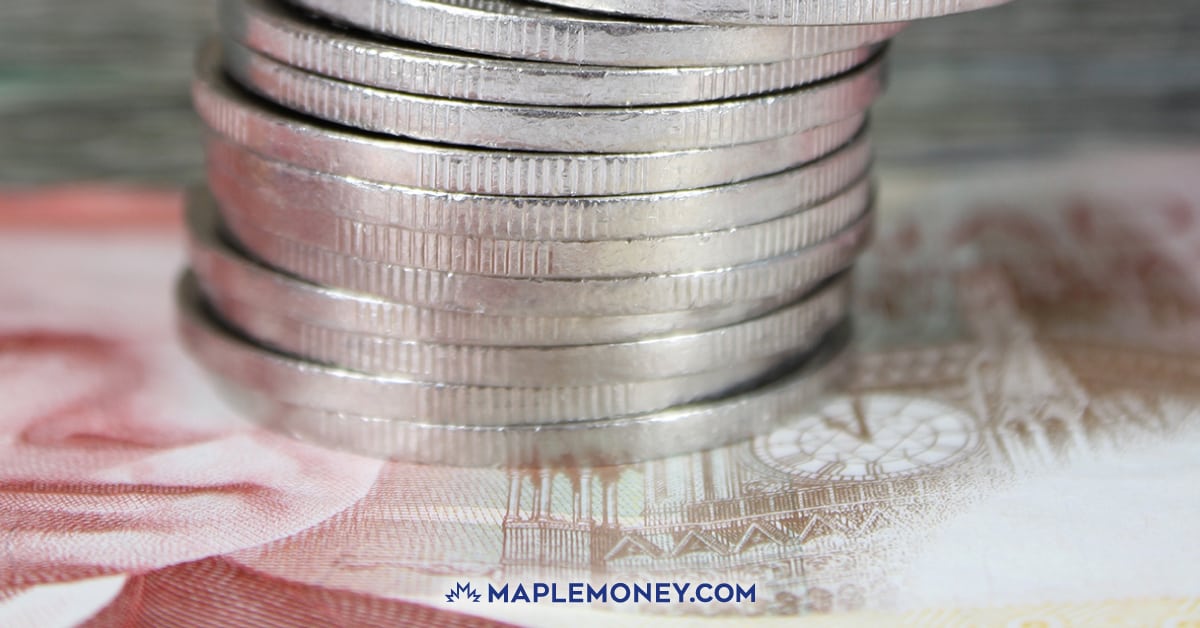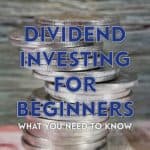Dividend Investing for Beginners: What You Need to Know

What’s not to like about dividends? They are tax efficient, a source of passive cash flow that often grows over time, encourage a buy and hold mentality, and they pay an investor to do nothing! But what exactly is a dividend and how does someone investing know if it can be trusted?
Dividend Basics
A dividend is a payment made to a shareholder of a company. So, if a company pays a 10-cent annual dividend and you own 100 shares, you would receive 10 dollars a year ($0.10*100 shares).
A dividend is paid out of a companies’ earnings and is not considered an expense. So essentially, a dividend is what the company pays out to shareholders after revenues and expenses have been incurred over a period and do not impact the actual profitability of a company.
An important key to remember with dividend stocks is that they are paid at management’s discretion. This means that management could, in theory, cut or eliminate a dividend at any time with no warning. A company is not obligated to pay a dividend.
A dividend yield represents the return the payout offers an investor relative to the share price. If a stock is valued at $5 and pays a 10-cent dividend, the yield on the stock is 2% (0.1/5=2%). This yield will fluctuate as the share price changes. So if the stock price increases, the yield will decrease and vice versa.
Some final basics on dividends relate to the tax efficiency. Since the earnings of a company are taxed, and dividends are paid out of after-tax earnings, investors receive a credit where a dividend is taxed at a lower rate than your income tax rate to avoid double taxation. Easy enough, right? So what are the pros and cons of dividend investing?
Pros to Dividend Investing:
- Get paid to wait
- Monthly or quarterly tax-efficient cash flow
- Dividends tend to grow over time, something the Canadian banks have proved effective at
- Dividends act as a natural quality filter
- Reinvesting of dividends can be powerful thanks to compounding returns
- Keeps management honest, as they can’t make decisions that would jeopardize the dividend
Cons to Dividend Investing:
- Typically mature, slower growth companies pay a dividend
- Cash from a dividend can be put to other uses by a company that may generate better returns (growth projects, debt payments, share buybacks, etc.)
- While tax-efficient, they are still taxed at a higher rate than capital gains
- No guarantee a dividend is paid indefinitely
High Yield Stocks are often High Risk
Investors often get drawn to stocks with high yields. The idea of getting an annual distribution in the 5%+ range along with the potential of capital gains is very enticing. However, in most cases with high yielding stocks, all that glitters is not gold.
Generally, a high yield is a signal from the market that a dividend is at risk. Since there is no return without risk, it makes sense that the higher the yield on a stock, the higher the risk that is buried in the stock.
A high yield usually means that the share price has recently fallen a material amount (and in turn something bad is happening at the company) or that the market does not think the dividend can be sustained by a company.
Protect Your Dividends by Using the Payout Ratio
So how does one determine if a distribution is sustainable? The main metric to turn to is the payout ratio. In simple terms, the payout ratio is the annual dividend per share divided by the annual earnings per share.
Alternatively, it can be calculated by the total dividends paid over a year divided by the net income over the year. So if net income is $100 and a company pays $10 in dividends, the payout ratio is 10% (10/100=10%).
The higher the payout ratio is, the more at risk it is of being cut. A payout in excess of 100% means the company is paying more out in dividends than they make in earnings. This typically can only be sustained for so long through other sources like cash in the company’s bank account.
Like most things in investing, it is not quite so simple though. The above-defined payout ratio is a rather crude way to calculate a company’s payout. You can learn more about this ratio and how it should be calculated through this deep dive on the payout ratio calculation.
How to Invest in Dividend Stocks
While there is no silver bullet there are some things an investor can do to stack the deck in their favour:
- Stick to companies with a dividend yield no higher than 5%
- Look for companies that grow the dividend over time
- Focus on payout ratios below 100%
- Ensure the balance sheet is strong (low debt, some cash). If you don’t wish to do this analysis by yourself, you can view our up-to-date research on some of the top Canadian companies here.
- See what the dividend history is like
- Past cuts in the dividend may be a bad sign
- Consistent and growing dividends are best
Dividend investing can be a rewarding endeavour, and by keeping a few simple rules in mind, an investor can build a stable and reliable source of cash flows over time.
Picking the right dividend stocks yourself can be time-consuming, complicated, and most Canadians don’t want to analyze the financial statements of every company that they’re considering. To help you make an informed decision, you can get the latest research on the top dividend-paying companies in Canada for free, by signing up for the free trial at 5i Research (no credit card required). As part of the trial, you’ll also receive instant access to the dividend model portfolio, along with answers to over 57,000 investing questions. You’ll even receive a free question credit to ask the 5i Research Team your top investing/stock question. Sign up for the free instant access here.


Comments
The current dividend yield is usually fairly low when you first buy a dividend stock. So the growth rate of the dividend (some call it the dividend CAGR, or Cumulative Annual Growth Rate) is very important. If you cannot live on a dividend yield of 3% (i.e. $3 for every $100 you spend to buy the stock), estimate how much that dividend will likely be by the time you reach retirement. If the $3 dividend today has been growing at (say) 10% per year for decades, chances are it will continue to do so. If you plan to retire in ten years, that $3 dividend could well be ~$7.80 by then. If you can live on a yield of 7.8%, and the company is solid, then that’s the stock for you.
But remember the tax advantages of dividend income apply only to Canadian companies. If you buy a foreign stock, those dividends are fully taxed as income, i.e. you pay more tax. Only dividends from Canadian companies get the tax break. This is presumably because the Canadian companies have already paid some taxes, and so to fully tax the dividends when issued to Canadian investors would amount to unfair double taxation. (Remember this when an uninformed politician, or an informed one who ignores the facts in order to garner votes, threatens to remove the dividend tax credit because those investors are not paying a “fair” tax.)
Len, in your example the 7.8% yield you’re referring to is the yield on cost, not the actual current dividend yield.
Bernie:
I am not sure what point you are making.
Yes, the $7.80 represents a Yield on Cost of 7.8%, because in my hypothetical example you bought the stock for $100 (back when it was issuing a dividend of $3). Back then, the dividend was $3, and the yield was 3%.
Later, in my example, the dividend grew to $7.80 — which happens to represent a yield on cost of 7.8%.
The important point of my example was that the investor might not be able to live on $3 now, but if he or she could wait a few years, and the dividend continued to grow as fast as it had in the past, the investor would be getting a nice raise, and enough to live on.
I guess I confused things by choosing a hypothetical purchase price of $100, which made the future dividend and the yield on cost look identical. Next time I’ll know better.
Len, I’m not really trying to make a point. I fully understand what you’re saying as I’m a dividend growth investor like yourself. However, those unfamiliar with the strategy may be confused with what you’re saying. In the example you aren’t actually growing the yield. What you are growing is the dividend and yield on cost.
Thank you for a good article with lots of info. I don’t mean to poopoo on the info, but one big disadvantage of dividend investing is, you most likely will not gain enough to achieve your financial goals.
Concentrating on dividend to achieve your money growth goals is like showing someone how to make garlic bread at a seafood buffet. Sure you will enjoy an awesome garlic bread, and not eat the seafood, but you won’t be getting your money’s worth.
Another big “Con” is, what if the stock falls and keeps on falling. Most people will continue to hold it and comfort themselves by saying I am still getting a dividend. The amount of dividend you get is far less than what you are losing on your shares. That’s a guarantee.
Everyone needs to use a retirement online calculator of some sort and figure out the % gains you need every year to allow you to retire adequately. You may need 15%, 20% or 30% each year. Dividend investing definitely won’t get you near those values. And if your stock drops, you are actually getting negative %.
Unless you have saved up a load of money, I bet most Canadians will need 10% or more gains per year. Using dividend as an investment vehicle would not be wise.
I would learn how to trade stocks properly, or do a simple trend trading method (eg. Monthly chart, if price exceeds the 20 moving average you buy, and if it drops below the average, you will sell. Done. Example: SPY, you would have bought on 2016 Apr 1 @ $204.35, and you would still be holding it right now $250.24.
That’s $45.89 profit per share = 22% gains in 1 year and 5 months.
Try other stocks like AAPL, or BIDU, etc. even bigger returns.
Again, dividend investing is a real method, but most likely won’t allow you to achieve your financial goal.
Why would you not just use a low cost Dividend ETF?
You could. But if you delve into the dividend ETFs, you will find they are rules based, and can buy (be forced to buy) some relatively weak companies.
When you make the extra effort to buy individual stocks, you can tailor your portfolio to your particular needs.
This is a fairly general answer; Brian Bollinger of Simply Safe Dividends dealt with this issue in greater detail, recently in a monthly newsletter.
Peter, I’ve been a stock dividend growth investor for a little over 9 years. Its worked out really well for me. My annualized return over the period is about 10% and DGR about 9%. I realize it would be much simpler to use dividend ETFs instead of stocks but I flat out don’t like the performance they show or the lumpy irregularity of the dividends. Its a whole lot easier to predict the income stream and its growth with dividend growth stocks.